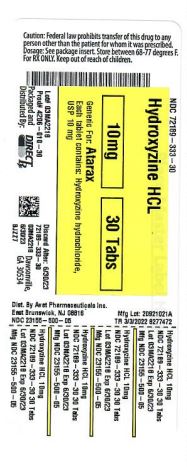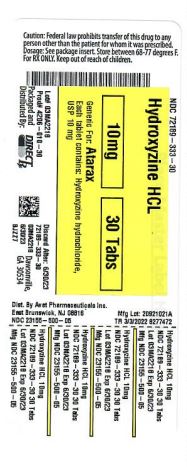Label: HYDROXYZINE HYDROCHLORIDE tablet
- NDC Code(s): 72189-333-30
- Packager: Direct Rx
- This is a repackaged label.
- Source NDC Code(s): 23155-500
- Category: HUMAN PRESCRIPTION DRUG LABEL
Drug Label Information
Updated March 3, 2022
If you are a healthcare professional or from the pharmaceutical industry please visit this version.
- Download DRUG LABEL INFO: PDF XML
- Official Label (Printer Friendly)
-
HOW SUPPLIED
Hydroxyzine Hydrochloride Tablets, USP are available as follows:
10 mg tablets: round, film coated white tablets. Debossed H on one side and 500 on the reverse side. They are available as follows:
Bottles of 100: NDC 23155-500-01
Bottles of 500: NDC 23155-500-05
Bottles of 1000: NDC 23155-500-10
25 mg tablets: round, film coated white tablets. Debossed H over 501 on one side and plain on the reverse side. They are available as follows:
Bottles of 100: NDC 23155-501-01
Bottles of 500: NDC 23155-501-05
Bottles of 1000: NDC 23155-501-10
50 mg tablets: round, film coated white tablets. Debossed H over 502 on one side and plain on the reverse side. They are available as follows:
Bottles of 100: NDC 23155-502-01
Bottles of 500: NDC 23155-502-05
Bottles of 1000: NDC 23155-502-10
Dispense in a tight container as defined in the USP, with a child-resistant closure (as required).
Store at 20° to 25°C (68° to 77°F) [See USP Controlled Room Temperature].
KEEP THIS AND ALL MEDICATIONS OUT OF THE REACH OF CHILDREN.
Distributed by:
Avet Pharmaceuticals Inc.
East Brunswick, NJ 08816
1.866.901.DRUG (3784)
logo
51U000000193US07Rev. 10/2019
-
DOSAGE & ADMINISTRATION
For symptomatic relief of anxiety and tension associated with psychoneurosis and as an adjunct in organic disease states in which anxiety is manifested: adults, 50 to 100 mg q.i.d.; children under 6 years, 50 mg daily in divided doses; children over 6 years, 50 to 100 mg daily in divided doses.
For use in the management of pruritus due to allergic conditions such as chronic urticaria and atopic and contact dermatoses and in histamine-mediated pruritus: adults, 25 mg t.i.d. or q.i.d.; children under 6 years, 50 mg daily in divided doses; children over 6 years, 50 to 100 mg daily in divided doses.
As a sedative when used as a premedication and following general anesthesia: 50 to 100 mg for adults and 0.6 mg/kg of body weight in children.
When treatment is initiated by the intramuscular route of administration, subsequent doses may be administered orally.
As with all potent medication, the dosage should be adjusted according to the patient's response to therapy.
-
OVERDOSAGE
The most common manifestation of hydroxyzine overdosage is hypersedation. Other reported signs and symptoms were convulsions, stupor, nausea and vomiting. As in the management of overdosage with any drug, it should be borne in mind that multiple agents may have been taken.
If vomiting has not occurred spontaneously, it should be induced. Immediate gastric lavage is also recommended. General supportive care, including frequent monitoring of the vital signs and close observation of the patient, is indicated. Hypotension, though unlikely, may be controlled with intravenous fluids and levarterenol or metaraminol. Do not use epinephrine as hydroxyzine counteracts its pressor action.
Hydroxyzine overdose may cause QT prolongation and Torsade de Pointes. ECG monitoring is recommended in cases of hydroxyzine overdose.
There is no specific antidote. It is doubtful that hemodialysis would be of any value in the treatment of overdosage with hydroxyzine. However, if other agents such as barbiturates have been ingested concomitantly, hemodialysis may be indicated. There is no practical method to quantitate hydroxyzine in body fluids or tissue after its ingestion or administration.
-
INDICATIONS & USAGE
For symptomatic relief of anxiety and tension associated with psychoneurosis and as an adjunct in organic disease states in which anxiety is manifested.
Useful in the management of pruritus due to allergic conditions such as chronic urticaria and atopic and contact dermatoses and in histamine-mediated pruritus.
As a sedative when used as a premedication and following general anesthesia, hydroxyzine may potentiate meperidine and barbiturates, so their use in pre-anesthetic adjunctive therapy should be modified on an individual basis. Atropine and other belladonna alkaloids are not affected by the drug. Hydroxyzine is not known to interfere with the action of digitalis in any way and it may be used concurrently with this agent.
The effectiveness of hydroxyzine as an antianxiety agent for long term use, that is more than 4 months, has not been assessed by systematic clinical studies. The physician should reassess periodically the usefulness of the drug for the individual patient.
-
CLINICAL PHARMACOLOGY
Hydroxyzine hydrochloride is unrelated chemically to the phenothiazines, reserpine, meprobamate or the benzodiazepines. Hydroxyzine is not a cortical depressant, but its action may be due to a suppression of activity in certain key regions of the subcortical area of the central nervous system.
Primary skeletal muscle relaxation has been demonstrated experimentally. Bronchodilator activity, and antihistaminic and analgesic effects have been demonstrated experimentally and confirmed clinically. An antiemetic effect, both by the apomorphine test and the veriloid test, has been demonstrated.
Pharmacological and clinical studies indicate that hydroxyzine in therapeutic dosage does not increase gastric secretion or acidity and in most cases has mild antisecretory activity.
Hydroxyzine is rapidly absorbed from the gastrointestinal tract and hydroxyzine's clinical effects are usually noted within 15 to 30 minutes after oral administration.
-
DESCRIPTION
Hydroxyzine hydrochloride, USP has the chemical name of (±)-2-[2-[4-(p-Chloro-α-phenylbenzyl)-1-piperazinyl]ethoxy]ethanol dihydrochloride.
stucture
Molecular Formula: C21H27ClN2O2 · 2HCl Molecular Weight: 447.83Hydroxyzine hydrochloride, USP occurs as a white, odorless powder which is very soluble in water.
Each tablet for oral administration contains 10 mg, 25 mg, or 50 mg hydroxyzine hydrochloride, USP. Inactive ingredients include anhydrous lactose, colloidal silicon dioxide, crospovidone, hypromellose, magnesium stearate, microcrystalline cellulose, polyethylene glycol, polysorbate and titanium dioxide.
- PRINCIPAL DISPLAY PANEL
-
INGREDIENTS AND APPEARANCE
HYDROXYZINE HYDROCHLORIDE
hydroxyzine hydrochloride tabletProduct Information Product Type HUMAN PRESCRIPTION DRUG Item Code (Source) NDC:72189-333(NDC:23155-500) Route of Administration ORAL Active Ingredient/Active Moiety Ingredient Name Basis of Strength Strength HYDROXYZINE DIHYDROCHLORIDE (UNII: 76755771U3) (HYDROXYZINE - UNII:30S50YM8OG) HYDROXYZINE DIHYDROCHLORIDE 10 mg Inactive Ingredients Ingredient Name Strength SILICON DIOXIDE (UNII: ETJ7Z6XBU4) HYPROMELLOSES (UNII: 3NXW29V3WO) MAGNESIUM STEARATE (UNII: 70097M6I30) CROSPOVIDONE (UNII: 2S7830E561) ANHYDROUS LACTOSE (UNII: 3SY5LH9PMK) CELLULOSE, MICROCRYSTALLINE (UNII: OP1R32D61U) POLYSORBATE 80 (UNII: 6OZP39ZG8H) TITANIUM DIOXIDE (UNII: 15FIX9V2JP) POLYETHYLENE GLYCOL, UNSPECIFIED (UNII: 3WJQ0SDW1A) Product Characteristics Color white Score no score Shape ROUND Size 7mm Flavor Imprint Code H;500 Contains Packaging # Item Code Package Description Marketing Start Date Marketing End Date 1 NDC:72189-333-30 30 in 1 BOTTLE; Type 0: Not a Combination Product 03/03/2022 Marketing Information Marketing Category Application Number or Monograph Citation Marketing Start Date Marketing End Date ANDA ANDA204279 03/03/2022 Labeler - Direct Rx (079254320) Registrant - Direct Rx (079254320) Establishment Name Address ID/FEI Business Operations DirectRx 079254320 repack(72189-333)


